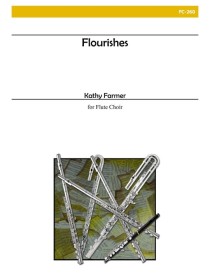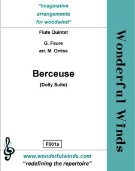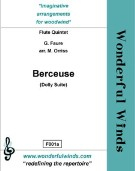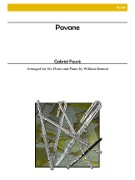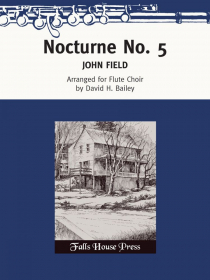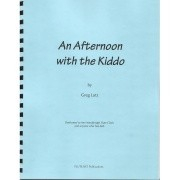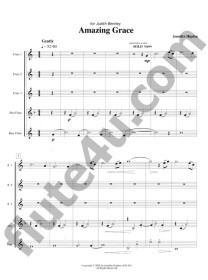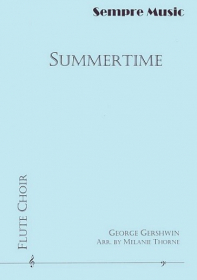Flute Choir (F-L)
-
Falanga, D :: Miscka
Miscka
Falanga, DThis piece has echoes of the minimalism of John Adams. Ostinato rhythms in the low register of the ensemble are associated with rhythmic cycles of 3 and 4 in the middle and upper registers. The composition is characterized by blocks of sound with offset overlapping of rhythmic and melodic motifs that create a texture that is very rhythmically articulated yet euphonic, and from which spring harmonies resulting from the overlap of the repeating melodic lines of the individual instruments. The form is divided into 3 parts (ABA), in a modal style where the Doric order dominates the composition. The title comes from the composer's love of inventing nicknames for members of his family, especially his wife, to whom it is dedicated.
Flute ensemble: piccolo, 3 flutes, 2 alto flutes, bass flute.
-
-
Faure, G :: Agnus Dei from 'Messe de Requiem'
Agnus Dei from 'Messe de Requiem'
Faure, GThis Agnus Dei is from Faure's 'Messe de Requiem', and is written for 4 standard flutes (octave divisi in the 1st flute), alto flute, bass flute, and piano. The beautifully expressive version for flute choir is arranged by David Heywood.
-
Faure, G :: Apres un Reve Op. 7, No. 1
Apres un Reve Op. 7, No. 1
Faure, G
The most well known song from Faure's 'Trois Melodies'. This arrangement shares lyrical the tune between 2 fls and alto, with the gentle accompanying quavers shared between the other players
-
Faure, G :: Berceuse (Dolly Suite)
Berceuse (Dolly Suite)
Faure, GA delicious flutey arrangement of this well known piece, also famous as the theme from 'Listen with Mother'.
-
Faure, G :: Berceuse (Dolly Suite)
Berceuse (Dolly Suite)
Faure, GA delicious flutey arrangement of this well known piece for 6 C flutes.
-
Faure, G :: Fantasie
Fantasie
Faure, GA lovely arrangement of this classic piece from the flute repertoire. The solo flute part is unchanged and is supported here by a flute choir. The accompanying parts are relatively simple, ranging from grade 4 to 6 in standard. Just as beautiful as the original, with a mournful opening section that is transformed into an exuberant romp showing the solo flute in full flight! A great chance to shine a new light on a perennial classic. Includes score and parts.
-
Faure, G :: MI-A-OU (Dolly Suite)
MI-A-OU (Dolly Suite)
Faure, GThis is a charming and elegant little waltz from Faure's Dolly Suite. Its playful character is perfect for flute quintet.
-
Faure, G :: Morceau de Concours
Morceau de Concours
Faure, GThis arrangement of a classic flute repertoire piece retains the original flute part as a solo line in the solo alto flute, with the accompaniment being taken by the low flutes. The solo is approximately grade 7, with the accompaniment parts being very straightforward.
Flute Ensemble - solo alto flute, alto flute, bass flute, contralto flute, contrabass flute, optional sub-contrabass flute.
-
Faure, G :: Morceau de Concours
Morceau de Concours
Faure, GThis arrangement of a classic flute repertoire piece retains the original flute part as a solo line, with the accompaniment being taken by the low flutes. The solo is approximately grade 7, with the accompaniment parts being very straightforward. Includes score and parts.
-
Faure, G :: Pavane
Pavane
Faure, G
This charming and popular piece was written in 1887. Obtaining its rhythm from the slow processional Spanish court dance of the same name, the Pavane ebbs and flows from a series of harmonic and melodic climaxes, conjuring a cool, somewhat haunting, Belle Epoque (French for Beautiful Era ) elegance.
-
Faure, G :: Pavane
Pavane
Faure, G
This exquisite work was arranged for the Marcel Moyse Memorial.
Instrumentation: 6 C Flutes, Piano, Alto Flute (optional for Flute 4 or 5), Bass Flute (optional for Flute 6), Flute 2 doubles on Piccolo
-
Faure, G :: Pie Jesu
Pie Jesu
Faure, G
From Faure's well-known Requiem, this was originally scored for solo treble voice and strings. 1990 NFA Newly Published Music Competition - Winner.
Instrumentation: 4 C Flutes, Alto Flute (or C Flute), Bass Flute.
-
Faure, G :: Pie Jesu from Requiem Op. 48
Pie Jesu from Requiem Op. 48
Faure, GOriginally for Soprano solo, this movement is taken from Faure's Requiem. This peaceful work makes the most of close harmonies between the instruments, and would also be suitable for an advanced group.
-
Faure, G :: Sicilienne
Sicilienne
Faure, G
A beautiful addition to any flute choir program. Instrumentation: 5 C Flutes, 2 Alto Flutes (or C Flutes), Bass Flute (or C Flute), Piano/Harp
-
Faure, G :: Sicilienne Op. 78
Sicilienne Op. 78
Faure, GThis beautiful Faure piece was originally written for 'cello and piano, but has appeared in many different arrangements, most famously for flute and piano. This version for flute quintet completely captures the mood of the original, with its dolce melody and rippling accompaniment.
-
Faure, J-B :: The Palms (Les Rameaux)
The Palms (Les Rameaux)
Faure, J-B
Rick Pierce presents this arrangement of Jean Baptiste Faure's The Palms, for solo C flute or voice, 3 C flutes, alto flute, and bass flute. A perfect setting for Palm Sunday.
-
-
Feliciano, J :: Feliz Navidad
Feliz Navidad
Feliciano, J
The concept of the expandable form gives a great deal of versatility in any flute choir situation. This arrangement works successfully using a quartet of 'C' flutes on the first four parts. As instruments are added they expand harmonic support, reinforce a line of another part and/or introduce new counter melodies. The integrity of the arrangement is never compromised. It is only enhanced. The expandable flute choir arrangement has been widely embraced by flute choirs worldwide. -
Field, J :: Nocturne No. 5
Nocturne No. 5
Field, J
John Field was an Irish composer, contemporary with Beethoven, whose music embraces the Romantic aesthetic which was emerging in all the arts of the time. Field wrote a large number of compositions, among them being 27 nocturnes (including Number 5) which ably demonstrate the delicacy of his compositional technique. Nocturne No. 5 is a beautiful, restful work which can provide an excellent contrast to more technically oriented works to help demonstrate the full range of expression which the flute choir is extremely well suited to produce.
Scored for 3 C flutes, alto and bass.



